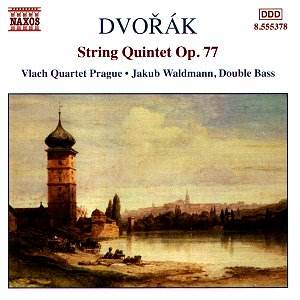This is not one of those chamber music CDs where the players
are recorded from a respectful distance. Here we are right in amongst
them, so that we can hear every detail of the intense interplay between
the instruments. That being so, it’s just as well that the playing of
the Vlach Quartet Prague, plus their double bass colleague Jakub Waldemann,
is superlatively good. Their leader, Jana Vlachová – the daughter
of the founder of the original Vlach Quartet, Josef Vlach – is one of
those first violins who really lead from the front, no mistake. But the
sound she produces is ravishing, full of colour and depth, and her partners
in the group match her worthily; this is a treat for the ears.
There are two full-length works on the disc, plus a
couple of interesting ‘odds and ends’. The major works are, firstly,
the wonderful quintet in G, scored for string quartet plus double bass,
and the charming Drobnosti for two violins and viola. Thus we
have one piece for string quartet with extra bass, and one piece
minus a true bass instrument. The odds and ends are an Intermezzo
which Dvořák had
originally included in the Quintet, and an Andante appassionato
in F from the incomplete String Quartet in A minor op.12.
The quintet with double bass is a scrumptious piece,
entirely characteristic of its composer. The presence of the bass suggests
that he wanted it to have a serenade-like character, and that is borne
out by the music. It has few shadows, and is full of delightful melodies,
dancing rhythms and rich, glowing textures. The solemn, slightly tentative
opening is a leg-pull, being even in the ‘wrong’ key. Soon this is swept
aside, and it’s pure enjoyment from then on. The Intermezzo on
track 5 was apparently originally intended to be the slow movement
of the double bass quintet, and it’s not quite clear why he replaced
it, as it is a very beautiful piece, equally as lovely in its way as
the existing movement.
Drobnosti (‘Miniatures’) is another unusual
work, scored for two violins and viola, and having something of the
character of a suite. The most original movement is the second, described
as a ‘Capriccio’, and having a wild, rustic character with much emphasis
on the augmented fourth or tritone. It is a tribute to Dvořák’s
instrumentation that you don’t miss the ’cello underpinning the other
three instruments – the work inhabits its own unique and very convincing
sound-world.
In the final track, we arrive for the first time at
the normal string quartet grouping; the movement from the aborted A
minor quartet is another fine piece, an outpouring of heartfelt lyricism,
which ends this fine CD in a gently thoughtful mood. Relatively unfamiliar
but very fine music, superb playing stunningly recorded – another fantastic
bargain from Naxos. How do they do it?
Gwyn Parry-Jones


